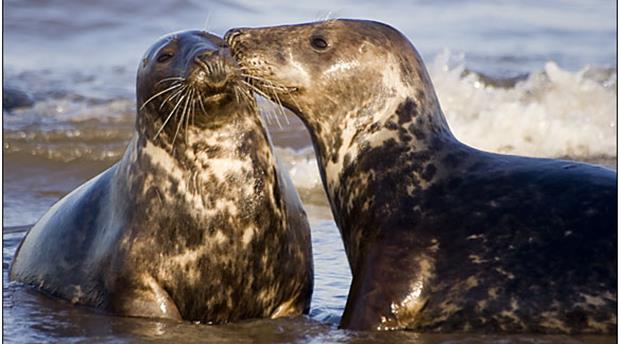This site uses cookies. By continuing to browse the site you are agreeing to our use of cookies. Read our privacy policy.
A year in the life of seals

The Moulting Season (January to May)
Pups from last season have been left by their mothers and are going it alone, exploring the Celtic Sea and teaching themselves to feed. These young seals may travel hundreds of miles and dive to depths of 120m to discover their new world. If their weight drops below 20kg, their chances of survival are slim, unless they are reported to British Divers Marine Life Rescue (01825 765546) or the Cornish Seal Sanctuary (01326 221361) by a concerned member of the public.
Adults have started their moult, which means they renew all their fur over about three weeks and with blood close to the skin surface they are particularly vulnerable to the energetic impacts of being disturbed and this is even more likely when seals are tightly packed in large groups – the panic of one seal spreads like a ‘domino’ effect leading to stampedes, so extra care is needed when watching them.
The Maintenance Season (May to August)
Seals begin to leave the safety of the large haul outs as offshore rocks become accessible. Seals wait for the sea to lift their body with the swash of a rising wave, using powerful claws to grip the slippery rocks. Under ideal circumstances seals prefer to go with the ‘flo flo’. Floating onto rocks at high tide and staying there until the next tide floats them off again. These offshore haul outs tend to host smaller numbers of seals and are closer to the precious feeding grounds. Feeding up after the annual moult and ready for the forthcoming pupping season is essential for all seals.
Anyone out on the water needs to be alert to the possibility of seeing a seal and being respectful of its need for space and leaving any seals as you find them. Seals rushing over rocky ledges can do themselves a lot of damage - claws get ripped out, bellies can be gashed and internal injuries result from steep flops down rocks – this can be particularly serious for heavily pregnant female seals. You can help by reporting any seal disturbance that you see to the Cornwall Wildlife Trust’s Marine Disturbance Hotline 0345 201 2626.
The Pupping Season (August to December)
For many non-breeding juvenile and male seals, it is back the business as usual on the mainland haul out beaches…but for female grey seals in Cornwall this is pupping time and most healthy females will be travelling long distances to reach their chosen pupping grounds just before giving birth. This may be at the back of a sea cave or on a remote beach. Most pups are born in October and November and are fed by their mother’s rich milk for up to three weeks. The pups are covered in long white fur for this time and may be left alone by their mums who may rest in the sea with a clear eye line to their pup. Pups and females are guarded by site specific beachmaster males who will protect them from wannabe suitors. As females leave to return to where they came from, new expectant mums arrive and so the seal year begins again with youngsters making their way out to sea when conditions in the open ocean are at their worst.

